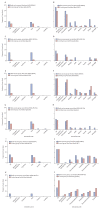Safety and immunogenicity of the two-dose heterologous Ad26.ZEBOV and MVA-BN-Filo Ebola vaccine regimen in children in Sierra Leone: a randomised, double-blind, controlled trial
- PMID: 34529962
- PMCID: PMC7613317
- DOI: 10.1016/S1473-3099(21)00128-6
Safety and immunogenicity of the two-dose heterologous Ad26.ZEBOV and MVA-BN-Filo Ebola vaccine regimen in children in Sierra Leone: a randomised, double-blind, controlled trial
Abstract
Background: Children account for a substantial proportion of cases and deaths from Ebola virus disease. We aimed to assess the safety and immunogenicity of a two-dose heterologous vaccine regimen, comprising the adenovirus type 26 vector-based vaccine encoding the Ebola virus glycoprotein (Ad26.ZEBOV) and the modified vaccinia Ankara vector-based vaccine, encoding glycoproteins from the Ebola virus, Sudan virus, and Marburg virus, and the nucleoprotein from the Tai Forest virus (MVA-BN-Filo), in a paediatric population in Sierra Leone.
Methods: This randomised, double-blind, controlled trial was done at three clinics in Kambia district, Sierra Leone. Healthy children and adolescents aged 1-17 years were enrolled in three age cohorts (12-17 years, 4-11 years, and 1-3 years) and randomly assigned (3:1), via computer-generated block randomisation (block size of eight), to receive an intramuscular injection of either Ad26.ZEBOV (5 × 1010 viral particles; first dose) followed by MVA-BN-Filo (1 × 108 infectious units; second dose) on day 57 (Ebola vaccine group), or a single dose of meningococcal quadrivalent (serogroups A, C, W135, and Y) conjugate vaccine (MenACWY; first dose) followed by placebo (second dose) on day 57 (control group). Study team personnel (except for those with primary responsibility for study vaccine preparation), participants, and their parents or guardians were masked to study vaccine allocation. The primary outcome was safety, measured as the occurrence of solicited local and systemic adverse symptoms during 7 days after each vaccination, unsolicited systemic adverse events during 28 days after each vaccination, abnormal laboratory results during the study period, and serious adverse events or immediate reportable events throughout the study period. The secondary outcome was immunogenicity (humoral immune response), measured as the concentration of Ebola virus glycoprotein-specific binding antibodies at 21 days after the second dose. The primary outcome was assessed in all participants who had received at least one dose of study vaccine and had available reactogenicity data, and immunogenicity was assessed in all participants who had received both vaccinations within the protocol-defined time window, had at least one evaluable post-vaccination sample, and had no major protocol deviations that could have influenced the immune response. This study is registered at ClinicalTrials.gov, NCT02509494.
Findings: From April 4, 2017, to July 5, 2018, 576 eligible children or adolescents (192 in each of the three age cohorts) were enrolled and randomly assigned. The most common solicited local adverse event during the 7 days after the first and second dose was injection-site pain in all age groups, with frequencies ranging from 0% (none of 48) of children aged 1-3 years after placebo injection to 21% (30 of 144) of children aged 4-11 years after Ad26.ZEBOV vaccination. The most frequently observed solicited systemic adverse event during the 7 days was headache in the 12-17 years and 4-11 years age cohorts after the first and second dose, and pyrexia in the 1-3 years age cohort after the first and second dose. The most frequent unsolicited adverse event after the first and second dose vaccinations was malaria in all age cohorts, irrespective of the vaccine types. Following vaccination with MenACWY, severe thrombocytopaenia was observed in one participant aged 3 years. No other clinically significant laboratory abnormalities were observed in other study participants, and no serious adverse events related to the Ebola vaccine regimen were reported. There were no treatment-related deaths. Ebola virus glycoprotein-specific binding antibody responses at 21 days after the second dose of the Ebola virus vaccine regimen were observed in 131 (98%) of 134 children aged 12-17 years (9929 ELISA units [EU]/mL [95% CI 8172-12 064]), in 119 (99%) of 120 aged 4-11 years (10 212 EU/mL [8419-12 388]), and in 118 (98%) of 121 aged 1-3 years (22 568 EU/mL [18 426-27 642]).
Interpretation: The Ad26.ZEBOV and MVA-BN-Filo Ebola vaccine regimen was well tolerated with no safety concerns in children aged 1-17 years, and induced robust humoral immune responses, suggesting suitability of this regimen for Ebola virus disease prophylaxis in children.
Funding: Innovative Medicines Initiative 2 Joint Undertaking and Janssen Vaccines & Prevention BV.
Copyright © 2022 Elsevier Ltd. All rights reserved.
Conflict of interest statement
Declaration of interests BKe was a full-time employee of Janssen Pharmaceutical Companies of Johnson & Johnson at the time of the study. NG, ML, AG, DH, VB, KL, BC, CR, and MD were full-time employees of Janssen Pharmaceutical Companies of Johnson & Johnson at the time of the study, and declare ownership of shares in Janssen Pharmaceutical Companies of Johnson & Johnson. DW-J reports grants from the Innovative Medicines Initiative and non-financial support from Janssen Vaccines & Prevention BV during the conduct of the study; and grants from the Coalition for Epidemic Preparedness Innovations and non-financial support from Janssen Vaccines & Prevention BV outside the submitted work. HL reports grants from GSK and Merck outside the submitted work. All other authors declare no competing interests.
Figures




References
-
- Centres for Disease Control and Prevention. 2014–2016 Ebola outbreak in west Africa. 2019. [accessed June 23, 2020]. https://www.cdc.gov/vhf/ebola/history/2014-2016-outbreak/index.html .
-
- Lo TQ, Marston BJ, Dahl BA, De Cock KM. Ebola: anatomy of an epidemic. Annu Rev Med. 2017;68:359–70. - PubMed
-
- Centres for Disease Control and Prevention. Cost of the Ebola epidemic. 2019. [accessed June 23, 2020]. https://www.cdc.gov/vhf/ebola/history/2014-2016-outbreak/cost-of-ebola.html .
-
- WHO. Ebola virus disease Democratic Republic of the Congo: external siguation report 97/2020. 2020. [accessed Aug 12, 2021]. https://www.who.int/publications/i/item/10665-332434 .
Publication types
MeSH terms
Substances
Associated data
Grants and funding
LinkOut - more resources
Full Text Sources
Medical
Miscellaneous

